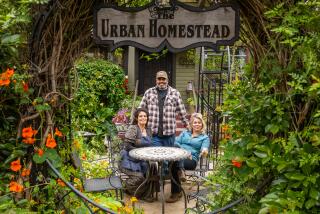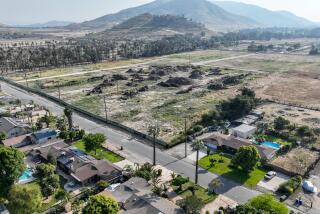Farm Worker Housing Project to Open : Development: Growers fear that the Rancho Sespe complex will turn their orchards into suburbs.
A long-awaited housing project just outside of Fillmore that will provide homes for 500 farm workers will officially open Saturday despite protests from growers who feel the project may turn their orchards into suburbs.
Farm worker families on Saturday will move into the complex, named Rancho Sespe after a 4,300-acre labor camp that once housed 100 United Farm Worker families on the other side of town.
The farm workers were evicted from the original Rancho Sespe two years ago after a protracted labor dispute that had lasted almost a decade.
Built with the help of public funds from the federal Farmers Home Administration and the state Department of Housing and Community Development, the new project sits on 20 acres.
It is owned by the Rancho Sespe Workers Improvement Assn. Corp., the group of tenants who will live at the complex. The association bought the land for just over $200,000.
Although tenants and supporters of the project say the new homes will unite a community of Mexican families that was once splintered, there are fears among some residents of Fillmore and Piru that the farm worker settlement could become a ghetto isolated from both towns.
Some people privately call the multicolored complex an eyesore, dubbing it “Rainbow City” because of the bright pink, yellow, green and gray shades used to paint it. But the growers who surround it view it as a threat to their businesses.
Set in the heart of the agricultural belt, the two-story homes are a symbol of what growers fear most, the conversion of the eastern Santa Clara Valley into housing tracts.
“I think socially, ethically, economically, it’s wrong,” said Rex Laird, executive director of the Ventura County Farm Bureau. “It goes against every rule, guideline and policy that the county uses.”
The project includes 50 apartments, but a second phase is now being planned that would add 50 more homes by 1992. When those homes open, about 500 people will be living at Rancho Sespe completely surrounded by orchards.
Cabrillo Economic Development Corp., the nonprofit agency that helped Rancho Sespe workers build the project, planned it as a self-contained community, designing a child-care and community center.
Ernie Morales, a former Fillmore mayor and a director at Cabrillo, said Rancho Sespe workers waited for years for the county to find a solution to their problem before they finally decided to build housing for themselves.
Morales, whose wife was born at the original Rancho Sespe labor camp, said, “They’re very anxious to move in. They’ve been waiting a long time.”
The dispute began in January, 1979, when Rivcom, the company that still owns the 4,300-acre ranch, originally bought it and fired 200 workers who had just voted to join the United Farm Workers. Rivcom also evicted about 500 workers from two labor camps.
Farm workers resisted eviction, and two years ago, when Rivcom closed down its labor camps, more than 100 families were forced to move in with relatives or leave the county, Cabrillo Project Manager Jesse Ornelas said.
Affordable housing has always been a problem for many low-income families who live in Ventura County, but particularly for non-union farm workers who are among the lowest wage earners in the county, Ornelas said.
Farm workers earn between $10,000 and $15,000 a year picking fruit and vegetables in the fields, a spokesman for the United Farm Workers said.
With rising real estate prices driving rents up countywide, there is little available affordable housing for farm workers, Ornelas said.
Rancho Sespe tenants will pay about half as much to live in their new homes as tenants in similar housing projects elsewhere in the county. Rents for apartments range from $283 to $383.
For Ninfa Zepeda, 41, a Rancho Sespe tenant, rent payments will be cut by nearly half. Now living together in a small apartment in Fillmore, Zepeda and her parents will move into separate apartments.
Zepeda had watched for nearly a year as construction crews pounded nails and sawed boards at the new housing project outside Fillmore, visiting every week to monitor its progress.
With moving day nearing, Zepeda walked through mud past the newly painted pink doors of her apartment, talking of the struggle it took to build it.
“We fought for this project so we could have better homes,” said Zepeda, who lived without gas and sometimes without water at the original Sespe Ranch labor camp nearly 10 miles away. “We’re finally going to live together again like we did before.”
But it has also been a hard-fought battle by growers to keep the complex from opening. Five years ago, growers fought the Rancho Sespe farm workers by challenging the county permit issued to allow construction in the orchards. They maintain that a housing project does not belong in the farm belt.
Many of the complaints about the project stem from the same residents who did not want it to be built in their city, Ornelas said. When Cabrillo looked for land to build in Fillmore and Piru, it took the agency three years, because of lack of cooperation, he said.
Amy Albano, an attorney who represented the farm workers in a lawsuit growers filed against the county in 1985, said the legal challenge took her clients to an appellate court, where their right to build in an agricultural zone was upheld.
Albano said the project has met every condition imposed upon it by county planners, including construction of a water tank, a bus turnaround and a buffer zone to separate it from the groves.
The challenge to Rancho Sespe has moved from the courtroom to town hall meetings where preservation of farmland is discussed.
County Supervisor Maggie Erickson said she is still besieged by Fillmore and Piru residents who complain about the project.
“They’re angry. They feel like they’ve been let down” by county planners, Erickson said.
Although he objects to the colors used to paint the project, Fillmore Councilman Roger Campbell said his main objection is that the complex will create an enclave 3 miles away from the nearest town.
“They’re going to feel segregated,” Campbell said. “They should be part of the community. They shouldn’t be out in a block of trees.”
More to Read
Sign up for Essential California
The most important California stories and recommendations in your inbox every morning.
You may occasionally receive promotional content from the Los Angeles Times.










